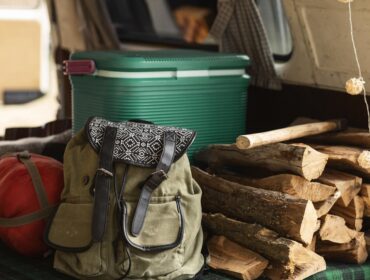The most beautiful bathroom views are in the wilderness. Imagine doing your business and looking up toward timeless mountains or onto a field of endless colorful wildflowers. The basics of camping bathroom etiquette are well worth the rewards and essential to any adventure. However, a lack of etiquette can be hazardous. The more people who venture outside, the more human waste there will be and more potential for long-lasting toxic impact on natural land. Whether it’s front country or back country camping, mastering the camping bathroom basics can minimize a stink in more ways than one.
Why is Camping Bathroom Etiquette Important?
The short answer is, we need to protect natural land, drinking water sources, and wildlife. Have you been on a hike and seen toilet paper or wet wipes nearby? It’s unsettling and a clue for what could be lingering nearby… Someone else’s business. Without widely adopted etiquette and awareness, there could be access restrictions, expensive restoration, and tarnished wilderness. With ethical initiatives like Leave No Trace and hiking know-how, we can work together to maintain natural land — one #2 at a time.
Leave No Trace
The best place to start our journey is brushing up on Leave No Trace. This is an easy-to-follow guide to outdoor ethics rooted in scientific research that exists solely to protect the natural world. Leave No Trace breaks it down with seven easy-to-digest principles.
- Plan ahead and prepare
- Travel and camp on durable surfaces
- Dispose of waste properly
- Leave what you find
- Minimize campfire impacts (be careful with fire)
- Respect wildlife
- Be considerate of other visitors
The Seven Principles are well-established and widely known, but they are not static. The Leave No Trace Center for Outdoor Ethics continually examines, evaluates, and reshapes the Principles.
Hiker’s Guide to Packing (a Toilet)
Just like Principle 1: Plan ahead and Prepare, you can bet you’ll be packing for a bathroom break. It’s best practice to pack a full toilet no matter how long your journey may be. The first step to packing your toilet is to research the expectations for where you’re going camping and plan for the duration of your trip. There will be four types of camping when it comes to your business.
- Pack it Out Camping – Just like food waste, human waste will need to be packed out with you in wag bags or other methods of transport.
- Cat Hole Camping – This is the ‘dig a hole’ method. Cat holes are the most widely accepted method of waste disposal.
- Frontcountry Camping – We won’t exclude this option, but you won’t need to bring much as you’ll probably be closer to modern plumbing than the other more remote styles of camping.
- Bring Your Own Toilet (BYOT) Camping. This might be the most luxurious option when it comes to doing your business in the great outdoors.
Pack It Out Camping
Some places restrict cat holes and any waste left behind, including human waste. Usually these places are ecologically sensitive or highly trafficked. For example, Zion National Park asks guests to “be prepared to pack it out.” Some dedicated adventurers pack out their human waste on every trip regardless of expectations because it’s seen as the most respectful.
When you’re carrying human waste, it’s extremely important to keep it separate from food or anything that needs to stay clean for the duration of your trip. If you’re packing overnight, you’ll need to store all smelly waste at least 100 meters away from your campsite in something like Bear Vault. This is because animals are known to be attracted to the smell of feces and they will be sure to visit your campsite to see what’s going on.
What to Bring for Pack it Out Camping:
- Resealable plastic bags or ‘wag bags’ – Wag bags are pre-made waste bags with kitty litter that dehydrate human waste, making it less stinky and less heavy to pack out. You can buy other bags made for this purpose but some campers use gallon plastic bags found in your kitchen. You can add tea bags or any other organic and pleasant-smelling elements to make it less stinky.
- Coghlan’s Personal Toilet Tissue – It’s safe to use toilet paper because you won’t be leaving it behind. Just be sure to keep it with your human waste.
- Unscented hand sanitizer – This element is sometimes forgotten but can be critical to staying well on a camping trip. Be sure to use hand sanitizer or another form of unscented cleansing after using the toilet to minimize the possibility of transferring germs.
Cat Hole Camping
The most common and widely accepted method of waste disposal is to dig a cat hole. You’ll need to follow a few steps to maximize decomposition, keep your campsite animal-free, and properly respect natural land.
Step 1: Walk at least 200 feet from water sources, trails, or campsites. Be aware of surfaces as instructed in Principle 2: Travel and Camp on Durable Surfaces.
Step 2: Use a trowel to dig a hole that’s 6 to 8 inches deep. This can be 4 to 6 inches in desert climates.
Step 3: Do your business.
Step 4: Pack out your toilet paper in a resealable plastic bag or add to your cat hole, depending on the climate.
Step 5: Fill up your cat hole and properly disguise it to look natural and untouched.
Step 6: Wash your hands with unscented hand sanitizer or another cleanser.
Now that we know how to make a cat hole, you’ll only need to bring a few essential items to dig your hole with skill and precision.
What to bring for Cat Hole Camping:
- Coghlan’s Backpacker’s Trowel – This lightweight and durable trowel is essential for digging a cat hole. For the low price point, this is a staple for adventurers.
- Coghlan’s Personal Toilet Tissue – Keep track of your TP with two rolls of 140 biodegradable sheets.
- Unscented hand sanitizer – This element is sometimes forgotten, but can be critical to staying well on a camping trip. Be sure to use hand sanitizer or another form of cleansing after using the toilet to minimize the possibility of transferring germs.
Frontcountry Camping
If you’re camping close to an access road, chances are you’re close to a designated bathroom. If you’re not as close you thought you’d be, check out cat hole camping on how to go #2 with proper camping bathroom etiquette. Regardless, it’s best practice to bring some of the essentials yourself.
What to Bring for Frontcountry Camping:
- Coghlan’s Personal Toilet Tissue – Keep track of your TP with two rolls of 140 biodegradable sheets.
- Unscented hand sanitizer – This element is sometimes forgotten, but can be critical to staying well on a camping trip. Be sure to use hand sanitizer or another form of cleansing after using the toilet to minimize the possibility of transferring germs.
Bring Your Own Toilet Camping
This option might just feel like home. If you’re not feeling the ‘dig a cat hole’ method in parks and places that don’t require you ‘pack it out’ this might be for you. Portable camping toilets resemble the modern day toilet that we know and love. This makes it more comfortable and familiar for some campers to do their business.
What to Bring for BYOT Camping:
- A portable toilet of your choice
- Coghlan’s Personal Toilet Tissue -Keep track of your TP with two rolls of 140 biodegradable sheets.
- Unscented hand sanitizer – This element is sometimes forgotten, but can be critical to staying well on a camping trip. Be sure to use hand sanitizer or another form of cleansing after using the toilet to minimize the possibility of transferring germs.
No matter which camping style you prefer, properly taking care of business is essential to a successful trip and becoming a reliable and respectful part of the bigger picture.
You know a relationship is getting good when you can talk about number two. Your relationship with camping, hiking, and the outdoors can only get better once you can leave your camping trip feeling like you don’t leave something behind that shouldn’t be there. So, get out there and do your business with confidence. There is no feeling than revisiting a modern day toilet after using a cat hole or a wag bag for days, and knowing you did it with proper camping bathroom etiquette.
Article by Christin Workman
Christin (she/her) is a writer and outdoor enthusiast. She’s a backpacker, hiker, ‘baby’ climber and a stop-and-smell-the-wildflowers kind of adventurer. Christin lives in Colorado with her husband, Rhodesian Ridgeback and a myriad of plants. When she’s not playing with words, she’s either out in backcountry, tending to the garden or practicing aerial arts.




